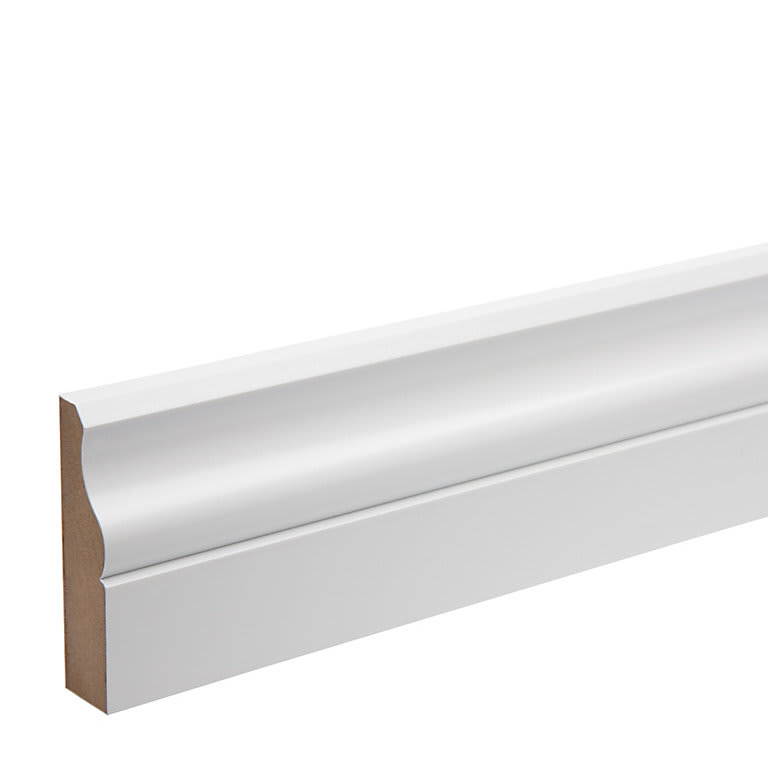Ogee Architrave
(3 Products)Ogee profile architrave is a type of architectural moulding that features a distinctive "S" shape design. The profile consists of a concave curve that transitions smoothly into a convex curve, creating a flowing and elegant shape that adds character and style to interior spaces. The S-shaped curve creates a sense of depth and movement that draws the eye, while the delicate curves and contours add a touch of sophistication and elegance. This makes the ogee profile architrave a popular choice among homeowners and interior designers who want to add a touch of luxury and refinement to their spaces.
What Is Ogee Architrave?
Ogee stands as a firm favourite in the vast world of architectural mouldings. Ogee architrave is a refined and elegant choice for adding a touch of sophistication to interior spaces.
The ogee profile, with its distinctive S-shaped curve, creates a sense of depth and character that elevates the overall aesthetic of the architrave.
The ogee profile architrave features a concave curve, known as the "cove," that transitions smoothly into a convex curve, referred to as the "swell."
This intricate design creates a visually pleasing and timeless look that is often sought after by those who appreciate fine craftsmanship and attention to detail in their interior design.
As well as selling Ogee Skirting Board, we also stock a host of other skirting board profiles. Similarly, we sell a huge range of architrave products, from MDF architrave to softwood architrave, in a variety of styles and profiles.
For all other products and categories available for order online, including timber products, insulation and sheet materials, please navigate to the headers located at the top of the page.
Ogee Architrave Key Features
- Sweeping curved profile detail
- Provides a smooth finish to any interior
- Available in various lengths
- Provides a smooth surface that is ideal for painting or finishing
- Classic and timeless appeal
The Purpose Of Architraves
Architrave is the decorative moulding that frames a door or window. Its primary purpose is to cover the joint between the door or window frame and the wall, and it also adds an elegant finishing touch to any interior design project.
Architrave comes in various styles and sizes, from simple square-edged designs to more intricate, detailed mouldings.
The most popular materials for architrave include MDF, softwood, and hardwood.
Frequently Asked Ogee Architraves Questions
How Does The Colour of Ogee Architrave Impact The Overall Look of a Room?
The colour of the ogee architrave can have a significant impact on the overall look of a room. Lighter colours can make a room feel brighter and more spacious, while darker colours can add warmth and depth to a space.
Additionally, choosing a colour that complements or contrasts with the wall colour can help create a cohesive and visually interesting look.
Can Ogee Architrave Be Used in Minimalist Interior Design?
While ogee architrave is often associated with more traditional interior design styles, it can also be used in minimalist design. Choosing a simple ogee profile without too much ornate detail and pairing it with a neutral colour palette can create a minimalist yet sophisticated look.
What Is A Primed Ogee Architrave?
A primed ogee architrave refers to an architrave that has been pre-coated with a primer or base coat of paint. Primed products tend to receive two coats of primer/basecoat.
Primed ogee architraves are commonly available in the market and are designed to save time and effort during installation and painting.
What's more, the primer on primed architraves acts as a protective layer, helping to seal the surface and protect the architrave from moisture, dust, and other environmental factors. This can enhance the durability and longevity of the architrave, making it more resistant to wear and tear over time.
What Is The Difference Between Ogee & Torus Architrave?
Ogee and torus architraves are two popular types of decorative mouldings used for framing doors, windows, and other openings in buildings.
Here are the key differences between Ogee and Torus architrave:
- Profile shape: Ogee architrave has an S-shaped profile with a concave curve at the top and a convex curve at the bottom. In contrast, torus architrave has a rounded profile with a semi-circular curve at the top and a smaller convex curve at the bottom.
- Decorative detailing: Ogee architrave tends to have more intricate and elaborate detailing, while torus architrave is simpler and more understated.
- Style: Ogee architrave is often associated with traditional or classic interior design styles due to its ornate and decorative profile. Torus architrave, on the other hand, is more versatile and can be used in a wider range of interior design styles, including contemporary and minimalist.
Can I Still Achieve a Consistent Look With Ogee Architrave If I Have Limited Material?
Yes, it's possible to achieve a consistent look with ogee architrave even if you have limited material.
One approach is to use ogee architrave selectively, for example, only on certain focal points or key areas of the room, such as around the main entrance or a fireplace. This can create a cohesive and visually appealing look without requiring as much material as using ogee architrave throughout the entire room.
However, before actioning any project it is vital to ensure that you have enough material to hand and have carried out all of the necessary preparatory work.
What Are Window Boards?
Window boards, most commonly known as window sills or window ledges, are flat surfaces that run horizontally at the base of a building's windows. They can be found on both the inside and outside of the building. Typically, window boards are made of materials such as wood, MDF, or PVC. These boards serve both practical and decorative purposes.





